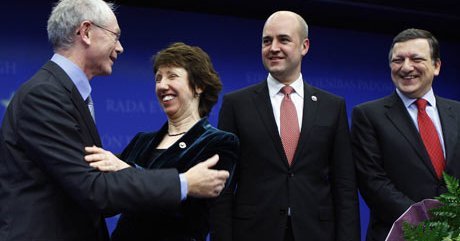The first President of the EU is Herman Van Rompuy, former Prime Minister of Belgium and member of the European People’s Party. He took charge during a crucial and instable period for his country, where the political crisis was intense and the peril of a possible Belgian dichotomy constituted a realistic scenario. Nevertheless, thanks to Van Rompuy’s “consensus capability”, Belgium managed to come out of the political dead-lock intact.
This “consensus capability” characterizing the new President was the main reason for his appointment by the European Leaders, as his new competences will be mostly related to coordination of the domestic functions of the EU, a task that requires accurate cost-benefit calculation and ability to find compromise among conflicting national interests.
In addition, his political ideology until now has shown a characteristic pro-European orientation, whereas the attacks of the British Press condemning him for being a dangerous Federalist raised multidimensional questions.
On the other hand, the 8 Socialist leaders under the guidance of Gordon Brown unanimously backed Baroness Catherine Ashton, former EU Commissioner for External Trade. As a matter of fact, the reasons for such a choice were insufficient, as Ms. Ashton is inexperienced regarding negotiation and diplomacy in foreign policy issues. Furthermore, the international representation of the EU is now taken on by a British, and hence a pro-Atlantic orientation may be considered as set from the beginning.
Both personalities were the product of a political compromise among the European centre-right and the socialists.
Beyond any doubt, both personalities were the product of a political compromise among the European centre-right and the socialists. Nevertheless, the partial institutional rehabilitation of the EU may be questioned from a political perspective. The pro-European community rationally wonders how a representative of a state that has been looking reluctantly and fearfully to the political movements across the channel for decades can now exercise a truly pro-European foreign policy. How can those who call themselves pro-Europeans consider this choice rational?
The EU remains hence committed of the eternally unanswered question: what Europe do we want? Despite the relief of this institutional step forward, politically the EU remains a dwarf, imprisoned in the search for its ideological identity.


1. On 15 April 2010 at 01:47, by Gaute Replying to: Institutional certainty and political controversy
Replying to: Institutional certainty and political controversy
“He took charge during a crucial and instable period for his country, where the political crisis was intense and the peril of a possible Belgian dichotomy constituted a realistic scenario.”
Maybe a little late to react, but sorry to say so this is overstating another Belgian crisis. For the moment this ’crisis’ still hasn’t been resolved and will surely play up the next month. But the fact is that their isn’t a realistic scenario for a Belgian dichotomy, unless you can call our current federalized state a dichotomy, which would be hard with no less then 3 regions and 3 communes. Stability trough sheer complexity. Let me reassure you, Belgium isn’t about to burst.
By the way, he didn’t want to be PM at first and I think he was pretty happy to get out of that spot.
Follow the comments: |
|
